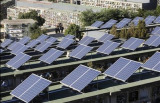 The domestic photovoltaic industry, which is in the industrial cold wave, has recently entered a policy honeymoon period and has successively ushered in a major favorable policy. On December 19th, the greatest good news ever came: The Executive Council of the State Council researched and determined five policies and measures to promote the healthy development of the photovoltaic industry on that day. This is the first time that the State Council Executive Meeting has taken the photovoltaic industry as a special study and issued specific guidance. According to industry sources, these five measures are called "five countries of photovoltaics," each of which is aimed at addressing the existing problems in the domestic photovoltaic industry. It is truly targeted and will become a programmatic policy guiding the healthy and orderly development of China's photovoltaic industry.
The domestic photovoltaic industry, which is in the industrial cold wave, has recently entered a policy honeymoon period and has successively ushered in a major favorable policy. On December 19th, the greatest good news ever came: The Executive Council of the State Council researched and determined five policies and measures to promote the healthy development of the photovoltaic industry on that day. This is the first time that the State Council Executive Meeting has taken the photovoltaic industry as a special study and issued specific guidance. According to industry sources, these five measures are called "five countries of photovoltaics," each of which is aimed at addressing the existing problems in the domestic photovoltaic industry. It is truly targeted and will become a programmatic policy guiding the healthy and orderly development of China's photovoltaic industry. Stimulated by this good news, there has been a collective surge in the U.S. stocks and domestic stock market photovoltaic sector. In terms of US stocks, Suntech Power led a 17.76% gain on the 19th. Big Brand New Energy, LDK Solar, Alss Solar, and China Light & Power both rose by more than 10%. Hanwha Solar, JA Solar, Trina Solar, Yingli, and Xi Huiguang Sunshine’s gains also exceeded 5%, while the US stocks’ solar index rose 10.59% to 187.27 points. In the domestic stock market, the photovoltaic sector witnessed a general increase on the 20th, and Hairun PV was at its daily limit. In the same period, Yijing Optoelectronics, Tuoxin Energy, and Tianlong Optoelectronics both had over 6% gains.
Actively develop domestic application market
The problem of the over-reliance of the domestic photovoltaic industry on the international market has been a long time ago. It has only become more pronounced and prominent under the “double reverse†background of Europe and the United States. As a result of this, the photovoltaic “State Five†clearly pointed out that it is necessary to “promote the domestic market for photovoltaic applications†and “strive to promote distributed photovoltaic power generation, encourage units, communities and families to install and use photovoltaic power generation systems, and promote photovoltaics in an orderly manner. Power station construction" to get rid of the heavy reliance on foreign markets.
It is worth noting that, in support of starting the domestic market, photovoltaic "State Five" also proposed to "improve the support policy", "according to the resource conditions to develop photovoltaic power plant sub-regional benchmark price of the Internet, the implementation of distributed power generation subsidies in accordance with the policy of electricity subsidies , According to the changes in costs, it is reasonable to reduce the on-grid tariff and subsidy standards."
According to Wang Runchuan, manager of solar energy supplier relationship management at JA Solar, there is currently only a “one size fits all†photovoltaic benchmarking price policy, so the developers get together to develop the power station in the western region with good lighting resources. “If the subregional benchmarking price is implemented, the on-grid tariff coverage will extend to the whole country, which will undoubtedly benefit the development of the power plant market.†In the future, the development of power plants in the eastern region will enter the blowout period,†said Wang Run.
For distributed photovoltaic power generation, the State Council executive meeting will explicitly subsidize electricity consumption. The advantage of the electricity subsidy is that it can avoid the swindling situation caused by the initial subsidy of a similar "Golden Sun" project.
In addition, the PV “State Five†also stated that “the mechanism of the Central Government’s financial support for the development of photovoltaics will be improved, and the PV power plant project will implement the same VAT preferential policies as wind powerâ€. According to an insider of a new energy power generation company, the current value-added tax rate for photovoltaic power generation is about 17%, while wind power value-added tax is about 8.5%. According to this estimation, if the same VAT preferential policies as wind power were implemented, it would be equivalent to an increase of 8 cents/kWh for the on-grid tariff of photovoltaic power plant project development, and a 20 MW plant would only generate annual power generation revenue. This will increase by 8%, which undoubtedly stimulates the enthusiasm of companies to invest in power plants.
Ni46 Strip,Ohmalloy1J46 Strip,Soft Magnetic Alloy Strip
Super Alloys Incoloy Alloys Co., Ltd. , http://www.nsnichrome.com